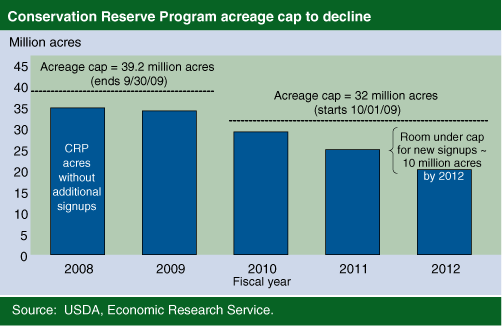Conservation Reserve Program Acreage To Decline; Will Benefits Also Fall?
- by Roger Claassen and Daniel Hellerstein
- 11/1/2008
The 2008 Farm Act continues a trend started in 2002 to emphasize land conservation as well as land retirement by encouraging good practices on land in production. For 2008-12, the Congressional Budget Office projects funding for land retirement programs (the Conservation Reserve Program (CRP) and the Wetlands Reserve Program) to be $13 billion, about 50 percent of mandatory spending in USDA conservation programs. Most of the balance (45 percent) will support conservation on working agricultural land through programs like the Environmental Quality Incentives Program (EQIP) and the Conservation Stewardship Program (CSP). The funding allocations represent a significant change from the 1990s, when the CRP dominated U.S. conservation policy and land retirement accounted for more than 90 percent of conservation payments to farmers. In recent years, CRP funding has also shifted toward partial field practices (such as field-edge filter strips and grassed waterways) that mitigate the environmental effects of land in crop production.
Over the next several years, CRP acreage could shrink rapidly. The Farm Act lowers the CRP acreage cap to 32 million acres (effective October 1, 2009) from the current enrollment of 34.7 million acres. By the end of 2011, CRP contracts on 13.9 million acres are scheduled to expire, creating ample room for new signups under the lower acreage cap. How many acres are actually enrolled is likely to depend largely on commodity supplies and prices.
As the CRP shrinks, can environmental losses be minimized? To some extent, previous USDA actions will limit environmental losses over the next few years. In 2006, USDA offered to renew or extend contracts on 28 million CRP acres scheduled to expire before 2010, and 83 percent of such offers were accepted. Extensions varied from 2 to 5 years, with longer extensions offered on land producing larger environmental benefits. Re-enrollments of 10 to 15 years were offered for the land with the highest benefits.
Because contract expiration will make room for new enrollments, the small, but growing segment of CRP known as continuous signup can continue to expand, even as the overall size of the program shrinks. Currently at about 4 million acres, CRP continuous signup can focus effort on environmentally sensitive areas and fund high-priority practices, including wetland restoration, that encompass small acreage but can produce relatively large environmental gains. Focusing on sensitive areas and high-priority practices could offset some of the environmental effects of fewer CRP acres. For example, filter strips that encompass only 1-3 percent of a drainage can remove as much as 50-90 percent of the nitrogen and phosphorous from runoff water. On the other hand, many environmental benefits, such as nesting habitat, are highly correlated with total acreage, and are not as easily replaced as CRP acreage declines.
This article is drawn from:
- Conservation Programs. (n.d.). U.S. Department of Agriculture, Economic Research Service.


